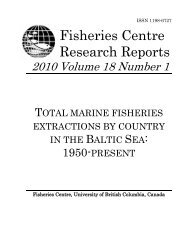report - Sea Around Us Project
report - Sea Around Us Project
report - Sea Around Us Project
Create successful ePaper yourself
Turn your PDF publications into a flip-book with our unique Google optimized e-Paper software.
Fisheries catch reconstructions: Islands, Part II. Harper and Zeller 67<br />
proportion of inshore subsistence catches (Vunisea et al., 2008). Those species were not necessarily<br />
favoured by the Nauruan locals a decade earlier (Dalzell and Debao, 1994; Gillett and Lightfoot, 2002).<br />
Presently, fishers indicated that most of their target species required further distances and hours at sea to<br />
catch, but regardless of where it came from, it was intended for their family consumption. Incidentally, all<br />
family members participated in one way or another in fishing activities (Vunisea et al., 2008; Gillett,<br />
2009) and the increasingly important reef gleaning activity is generally undertaken mainly by women<br />
(Chapman, 1987). Overall, the more detailed breakdown by Dalzell and Debao (1994) was applied to the<br />
total catch throughout the 1950-2008 time period.<br />
RESULTS<br />
Data supplied to FAO for Nauru would suggest incorrectly that essentially no fish were caught prior to the<br />
early 1960s (Figure 3a). Reported landings increased steadily from 100 t∙year -1 in 1963 to around 190<br />
t∙year -1 in 1991, before increasing substantially to around 500 t∙year -1 in 1993 and 1994 (Figure 3a).<br />
Thereafter, data supplied to FAO suggested a rapid decline throughout the 1990s to around 40 t∙year -1 in<br />
the early 2000s.<br />
Reconstructed catch estimates suggested a distinctly different picture (Figure 3a). Overall, the 1950-2008<br />
total catches were estimated at 23,150 t, being 3.4 times greater than the data supplied to FAO on behalf<br />
of Nauru. Note the slightly lower total estimates for 1993 and 1994 compared to data supplied to FAO.<br />
Reconstructed commercial catches increased from around 30 t∙year -1 in 1950 to around 360 t∙year -1 in<br />
1999, before declining rapidly to just under 70 t∙year -1 by 2008 (Figure 3a). Conversely, reconstruction<br />
suggested a decline in subsistence catches from 290 t∙year -1 in 1950 to a low of around 110 t∙year -1 in 1991,<br />
before increasing rapidly to over 350 t∙year -1 by 2008 (Figure 3a).<br />
The taxonomic breakdown applied to Nauru’s reconstructed fisheries catches (Figure 3b) is based on the<br />
<strong>report</strong>ed catch composition given by Dalzell and Debao (1994) for the commercial catches, and on<br />
Vunisea et al. (2008) for the subsistence sector. Commercial catches were dominated by Scombridae<br />
(56%), composed of 80% skipjack (Katsuwonus pelamis) 10% yellowfin tuna (Thunnus albacores) and<br />
10% other scombrids, followed by Carangidae (30%, mainly rainbow runner, Elagatis bipinnulata) as well<br />
as Lutjanidae (6%, mainly Lutjanus kasmiri), followed by coastal reef species such as surgeonfish (5%)<br />
and triggerfish (3%). Other taxa have been increasingly targeted more recently, due to ever more intensive<br />
fishing pressure. Overall, there is a predominance of pelagic species in local landings (Figure 3b).<br />
Nonetheless, far less of these landings are sold commercially; rather, they are intended for family<br />
consumption or sharing with other family members and neighbours. This shift to increasingly noncommercial<br />
basis was driven by the recent economical crisis and the weaker financial power of the<br />
Nauruan people (Vunisea et al., 2008; Gillett, 2009).<br />
DISCUSSION<br />
Nauru’s total domestic fisheries catches for the period 1950-2008 were estimated to be 23,150 t. This<br />
amount illustrates the historical importance fisheries have in meeting the island’s dietary requirements, a<br />
fact which cannot be readily inferred from the data <strong>report</strong>ed to FAO on behalf of Nauru. Small-scale<br />
fisheries are fundamental to many Pacific islands, nonetheless widespread lack of information on<br />
subsistence sector catches undervalues the social and economical importance of this sector (Zeller et al.,<br />
2006; Gillett, 2009) and may impact any successful form of ecosystem-based fisheries management<br />
(Pauly et al., 2002).<br />
The landings <strong>report</strong>ed to the global community on behalf of Nauru substantially underestimate total<br />
catches as estimated here for all but two years during the early 1990s. We assume that this peak in<br />
<strong>report</strong>ed landings coincides with the publication of the seminal work by Dalzell and Debao (1994) and<br />
Dalzell et al. (1996), who presented estimates of per capita catch rates. These studies were likely used to<br />
estimate Nauru’s 1993 and 1994 fisheries landings that were <strong>report</strong>ed to FAO. However, the human<br />
population counts for that decade were overestimated (Underwood, 1989), likely resulting in the higher<br />
<strong>report</strong>ed landings estimates as presented by FAO compared to our reconstructed estimates. We identified





![Nacion.com, San José, Costa Rica [Nacionales] - Sea Around Us ...](https://img.yumpu.com/26166123/1/190x245/nacioncom-san-josac-costa-rica-nacionales-sea-around-us-.jpg?quality=85)










